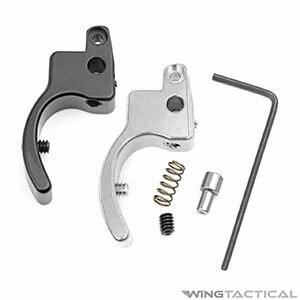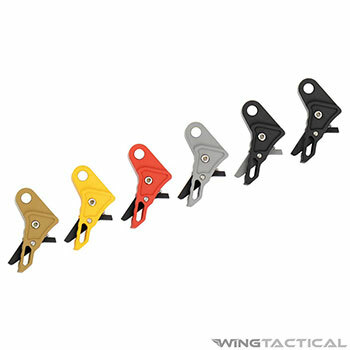If you’re still relying on the factory trigger included with your pistol, you may seriously consider upgrading it. Even high-quality pistols typically come with low-quality triggers that can impact your accuracy and even your safety in some cases. Wing Tactical specializes in supplying the best pistol trigger parts to gun owners. Think about ordering a pistol trigger assembly today so that you can make a dramatic improvement to your pistol by installing it.

How Installing a New Pistol Trigger Will Benefit You
There are so many upgrades that you can make to your pistol, but adding a new pistol trigger to it will be the easiest way to improve its performance and usability. You’ll find that improving your shooting skills with your pistol won’t seem like such a tall task anymore when you select the right pistol trigger assembly for it. You’ll be able to get a better feel for your firearm when it has an aftermarket trigger installed on it, and you’ll also discover that it’ll be both more accurate and even more consistent from now on.


Curved Trigger
A curved pistol trigger is the traditional "hooked" trigger on most pistols. With a curved trigger, you have a place to rest your finger on the trigger. For this reason, a curved trigger is more ergonomic for many pistol owners.
Opinions can vary greatly, but some gun owners claim that a curved trigger works best for fast shooting and is easier to use in slippery conditions. However, some also feel it's difficult to find the same spot on the trigger every time they shoot, so a curved trigger may affect consistency.

Flat Trigger
Some shooters claim they can get to know their favorite position better on a flat trigger and that they can better feel the pressure being applied. Others say that flat triggers feel lighter even though they are not. You may have more space to move your finger around on a flat trigger, which could work better with certain guns.
For example, our Killer Innovations Velocity Trigger Shoe for Glock replaces the factory Glock trigger. It allows the user to place the finger lower on the trigger for a lower pull weight, reducing the pull weight by approximately 18 percent.

Wing Tactical: A Leading Provider of Pistol Trigger Parts
Wing Tactical has been providing firearm parts and accessories, including many pistol trigger parts, for more than a decade. We serve everyone from active-duty military members and law enforcement professionals to civilian gun owners and even competitive shooters.
If you’re unhappy with how your firearm’s factory trigger is performing right now, the experts at Wing Tactical can set you up with a pistol trigger assembly that will let you personalize your gun to meet your needs. We carry pistol triggers from many of the top brands in the business, including Strike Industries, Apex Tactical, Killer Innovations, and more.
Stop using a factory trigger that isn’t going to deliver the performance, accuracy, and safety you expect from your firearm. Touch base with us today to hear more about the pistol triggers that will work best with your specific gun.
Frequently Asked Questions
Will an aftermarket pistol trigger impact my accuracy?
An aftermarket trigger with a lighter pull reduces the effort the shooter has to put on the trigger. With less focus on pulling the trigger, you can shift your attention to hitting your target.
Consider the weight of your gun and the weight of the trigger pull. If, for example, your pistol weighs one and a half pounds and the factory trigger pull is six pounds, the amount of pressure you need to apply to fire could cause the gun to move. Manufacturers are more concerned with safety and lawsuits than accuracy, but fortunately, the power is in your hands to make an upgrade with a trigger better suited for your pistol.
What are the benefits of upgrading your pistol trigger?
The trigger is a bit challenging to upgrade, but it is a great way to significantly impact performance and usability. Usually, gun manufacturers use a heavier trigger akin to MIL-SPEC firearms that is suitable for tactical use. MIL-SPEC stands for military specification. A duty firearm must meet specific criteria and be approved by an inspector to be considered "safe." Pull on a factory trigger anywhere between 5 and 12 pounds is a lower-quality trigger.
Although a quality aftermarket trigger will not turn an amateur into a world-famous shooter, a good trigger can help a gun owner build their shooting skills and reach their potential. A quality trigger also helps a pistol user gain greater control of their gun, which increases safety in stressful situations. A trigger upgrade is something worth considering for all gun owners who want maximum performance out of their firearm.
Will every aftermarket trigger fit on my gun?
Triggers are not one-size-fits-all. You will need to make sure you shop around for an aftermarket trigger that will fit the specific type of gun you own. If you buy the wrong trigger for your gun, it isn’t going to fit, and it will turn into a safety hazard if you attempt to use it anyway.
Who benefits the most from an after-market trigger?
Competitive shooters need a high-quality pistol trigger; factory triggers usually don't cut it. The quickest way to improve accuracy and consistency is with a trigger upgrade.
Those with pistols to defend their homes and families must be careful with the trigger pull weight. A trigger that is too light, like the ones used in competitive shooting matches, is not recommended for home defense purposes because a light trigger can get a homeowner in trouble.






